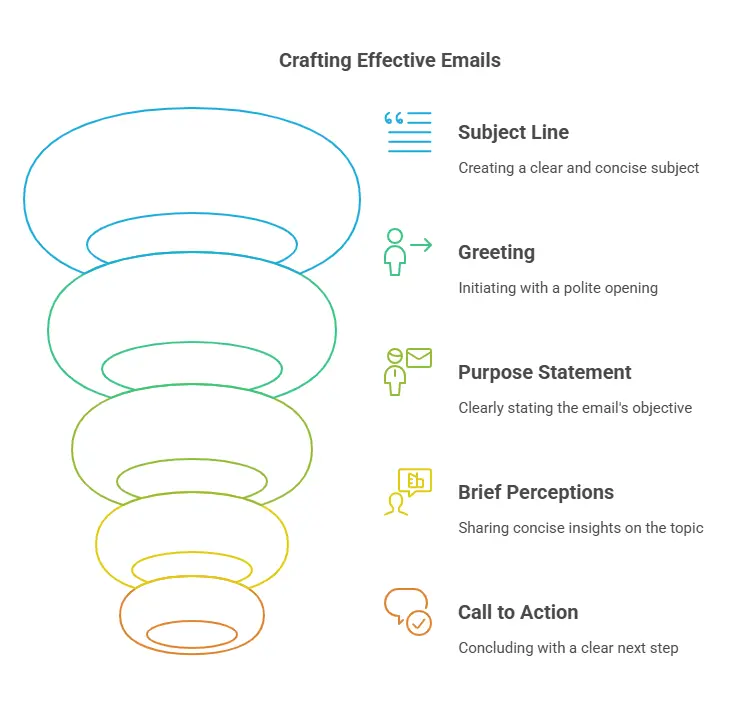Table of Contents
In engineering, communication is as important as computations and codes. Whether you are writing to a client, coworker, or manager, a well-written email shows professionalism and facilitates clear communication of your message. Engineers routinely balance technical knowledge, strict deadlines, and cross-functional teams; thus, learning efficient email communication is absolutely essential. This article will help you through fundamental email etiquette for engineers, from organizing your message to tone, formatting, and examples that will keep your communication clean, clear, and professional.
Master English speaking with Entri App! Enrol now!
How to Structure Your Email – The Ideal Format
A well-organized email makes your message understandable, orderly, and easy to react to. Engineers deal with technicalities a lot and hence use the same system, keeping things simple and open to knowledge so that nothing remains uncertain. Start with an appropriate subject line, follow it with a polite greeting, establish your purpose at an early stage, and provide a brief idea of your perceptions in the matter. End with a clear call to action or conclusion and add a professional closing with your phone number.
A good email will have a proper and professional format. Here’s a simple template engineers can use:
- Subject Line—Brief and to the point
- Greeting—Proper and respectful
- Opening Line—Hit the point at once
- Body—Provide related information (short and sweet)
Closing Line—End with a clear next step or thank you - Signature—Include your full name, designation, and contact details
Tips for Writing Clear and Professional Emails
1: Which of the sentences below is grammatically correct?
Here are some suggestions to upgrade your email game:
1. Use a Clear Subject Line
Keep it easy for the recipient to know what the email is about.
Example: “Request for Structural Design Review – Bridge Project”
Example: “Need help”
2. Be Concise, Yet Informative
Engineers are busy—don’t bury your key point in long paragraphs.
Use bullet points for complex info
Limit yourself to one main topic per email if possible
3. Use a Professional Greeting
Use “Hi [Name],” or “Dear [Title/Name],” unless the recipient is really well known. Avoid too-familiar openings like “Hey” in formal e-mails.
4. Be Nice and Formal
Even when racing against time, don’t be curt. Put in softeners like:
“Would you mind…”
“Could you please…”
“Just following up…”
5. Proofread Before You Send
Typos and grammatical mistakes take away from your professionalism. Do a quick spell-check or read it over again before you hit “Send.”
6. Avoid Jargon or Define It
Not every addressee is going to be familiar with engineering jargon. Define acronyms or spell them out where emailing non-engineer stakeholders.
7. End on a Professional Note
Choices are:
“Best regards”
“Kind regards”
“Sincerely”
And your name and contact information each time.
Spoken English Course for Guaranteed Confidence and Career Growth
Spoken English Course by Entri App: Enhance your communication skills, gain certification, and boost your career with confidence.
Join Now!Sample Emails
Sample 1: Requesting a Review
Subject: Review Request – Load Calculation for Building X
Dear Mr. Rao,
I hope you’re doing well. I’ve completed the preliminary load calculations for Building X and would need your review before final submission.
The document is attached. Please inform me if you need any additional data or clarification.
Best regards,
Riya Mehta
Junior Structural Engineer
XYZ Consultants | riya.mehta@xyz.com
Sample 2: Scheduling a Meeting
Subject: Meeting Request: Coordination on Steel Detailing – Mall Project
Dear Arya,
Could we meet for a short while this week to coordinate on steel detailing for the mall project? I am available on Tuesday and Thursday from 10 AM to 2 PM.
Please let me know a convenient time.
Best regards,
Rahul Mehta
Design Engineer | DEF Infra Solutions
Master English speaking with Entri App! Enrol now!
Conclusion
A basic ability every engineer should pick up is email etiquette. It’s more than just a question of presenting yourself as professional; it’s about getting your point of view over, using polite language, and providing value in your correspondence. Whether writing a customer update, a cross-functional team, or a senior engineer’s correspondence, a well-written email builds credibility and confidence. Good email organization, clear wording, and polite behavior help you to enable daily productive communication. In engineering, clarity saves time, lowers mistakes, and improves working relationships; hence, let your emails show the precision and professionalism your work reflects.
Spoken English Course for Guaranteed Confidence and Career Growth
Spoken English Course by Entri App: Enhance your communication skills, gain certification, and boost your career with confidence.
Join Now!Frequently Asked Questions
What should I avoid in professional emails?
Avoid slang, overly casual language, emojis, typing in all caps (which can seem aggressive), and lengthy, unstructured paragraphs. Keep your tone respectful and your message to the point.
Should I use “Reply All” when responding?
Only if everyone copied on the email needs your response. Otherwise, replying to the sender directly is more appropriate and helps reduce inbox clutter for others.
Can I use abbreviations or technical terms in emails?
Yes, but consider your audience. If you’re writing to someone within your team who understands the jargon, it’s fine. For clients or cross-functional teams, spell out terms or provide a brief explanation.
Is it necessary to add a signature in every email?
Yes, especially in professional or external communication. A standard email signature with your full name, job title, company, and contact details adds credibility and makes it easy for the recipient to reach you.
Can I use templates for routine emails?
Absolutely. Templates for routine communications (like status updates, meeting requests, or follow-ups) save time and ensure consistency—but always personalize them before sending.











